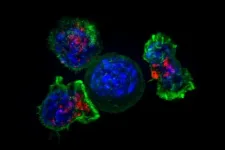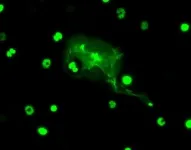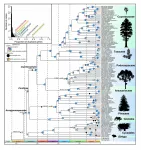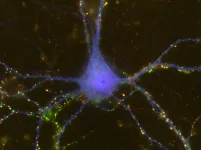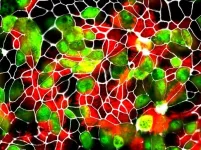(Press-News.org) LA JOLLA--Fighting a tumor is a marathon, not a sprint. For cancer-fighting T cells, the race is sometimes just too long, and the T cells quit fighting. Researchers even have a name for this phenomenon: T cell exhaustion.
In a new Nature Immunology study, researchers at La Jolla Institute for Immunology (LJI) report that T cells can be engineered to clear tumors without succumbing to T cell exhaustion.
"The idea is to give the cells a little bit of armor against the exhaustion program," says LJI Professor Patrick Hogan, Ph.D. "The cells can go into the tumor to do their job, and then they can stick around as memory cells."
This research builds on a decades-long collaboration between Hogan and LJI Professor Anjana Rao, Ph.D. Their work has shown the key role of proteins called transcription factors in the cellular pathway that triggers T cell exhaustion.
This work is important because T cell exhaustion continues to plague even the most cutting-edge cancer immunotherapies.
With CAR T therapies, for example, researchers take T cells from a cancer patient and "arm" them by altering the expression of genes that aid in the cancer fight. Researchers make more of these special T cells, which then go back into the patient. CAR T therapies are different from immunotherapies, which aim to activate the patient's existing T cell population.
With both approaches, T cell exhaustion rears its ugly head. "Many people have tried to use CAR T therapies to kill solid tumors, but it's been impossible because the T cells become exhausted," says study co-first author Hyungseok Seo, Ph.D., a former postdoctoral fellow in the Rao Lab who is currently working at Novartis.
The new study addresses this problem by giving T cells the ability to fight exhaustion itself.
To accomplish this, the researchers screened T cells to uncover which transcription factors could boost a T cell's "effector" program, an important step in readying T cells to kill cancer cells.
This screening process led the researchers to BATF, a transcription factor that they found cooperates with another transcription factor called IRF4 to counter the T cell exhaustion program.
In mouse melanoma and colorectal carcinoma tumor models, altering CAR T cells to also overexpress BATF led to tumor clearance without prompting T cell exhaustion. The CAR T therapy worked against solid tumors.
"BATF and IRF4 are cooperating to make T cells better," says Seo.
Further testing showed that while IRF4 is important, it shouldn't be overexpressed to the same degree as BATF. For maximum effect, BATF was overexpressed around 20 times more than in normal cells.
Encouragingly, some altered T cells also stuck around and became memory T cells. This is important because T cell exhaustion often prevents T cells from mounting a strong memory response to recurrent cancers.
"We didn't just increase the ability of T cells to fight exhaustion--we increased the ability of cells to fight tumors," says study co-first author Edahí González-Avalos, a graduate student in the Rao Lab who led the bioinformatic analysis for the project.
Hogan thinks overexpressing BATF could be a promising approach for improving CAR T therapies and for tackling some hard-to-treat cancer types, such as pancreatic ductal carcinoma. These types of cancers are known as "immunologically cold" because they don't spark a strong anti-cancer response from the immune system. T cells don't fight them in force.
Other laboratories have been exploring ways to make these cold tumors "hot," so they will attract T cells. The LJI team thinks a promising strategy would combine those approaches with targeting transcription factors to render T cells exhaustion-proof.
"We wouldn't necessarily need a transgenic approach to do this," says Hogan. "Maybe even an oral drug molecule could do it, if you knew what transcriptional pathways you wanted to go after."
The researchers emphasize that BATF is just one of many transcription factors that may prove important to manipulate when countering T cell exhaustion.
"We're going to keep looking for answers," adds González-Avalos.
INFORMATION:
The study, "BATF and IRF4 cooperate to counter exhaustion in tumor-infiltrating CAR T cells," was supported by the National Institutes of Health (grants AI109842, AI040127, DE028227, RR027366, OD018499); a AACR-Genentech Immuno-oncology Research Fellowship 18-40-18-SEO; a Donald J. Gogel Cancer Research Institute Irvington Fellowship; a University of California Institute for Mexico and the United States (UC-MEXUS) and El Consejo Nacional de Ciencia y Tecnología (UCMEXUS/CONACYT) predoctoral fellowship; NIH T32 predoctoral training grant in the UCSD Cardiovascular Bioengineering Training Program; Cancer Research Institute Irvington Fellowship; an Independent Investigator Fund (La Jolla Institute/Kyowa Kirin) and a Career Transition Award from the National Cancer Institute (K22CA241290).
Additional authors of the study include Wade Zhang, Payal Ramchandani, Chao Yang and Chan-Wang J Lio.
DOI: 10.1038/s41590-021-00964-8
About La Jolla Institute for Immunology
The La Jolla Institute for Immunology is dedicated to understanding the intricacies and power of the immune system so that we may apply that knowledge to promote human health and prevent a wide range of diseases. Since its founding in 1988 as an independent, nonprofit research organization, the Institute has made numerous advances leading toward its goal: life without disease.
BOSTON - Lymph nodes are critical to the body's immune response against tumors but paradoxically, cancer cells that spread, or metastasize, to lymph nodes can often avoid being eliminated by immune cells. Recent experiments by investigators at Massachusetts General Hospital (MGH) and Boston University School of Medicine provide insights on the details behind this immune evasion, which could help scientists develop strategies to overcome it. The findings are published in Nature Biomedical Engineering.
"We know that lymph nodes are often the first place cancer ...
A new USC study of a common, yet poorly understood type of white blood cell reveals the immune cell's response to pathogens differs greatly by sex and by age.
In this mouse study, males proved much more susceptible to a condition called sepsis than females. However, the scientists also found that the female disease-defense system is hardly perfect; their system changes with age to become nearly as harmful as the males'.
Those are the key findings in a study that appears today in Nature Aging.
The study has important implications for studying disease and cures, especially for sepsis, a condition in which the body's defense ...
WHAT:
A new study published in JAMA Neurology suggests that certain features that appear on CT scans help predict outcomes following mild traumatic brain injury (TBI). Patterns detected on the scans may help guide follow up treatment as well as improve recruitment and research study design for head injury clinical trials.
Researchers led by Geoffrey Manley, M.D., Ph.D., professor of neurological surgery at the University of California San Francisco, conducted CT scans in 1,935 subjects with mild TBI and followed their outcomes up to 12 months after injury.
This research was part of the Transforming Research and Clinical Knowledge in Traumatic Brain Injury (TRACK-TBI) study, a large research effort funded by the National Institutes of ...
Michigan State University ecologists led an international research partnership of professional and volunteer scientists to reveal new insights into what's driving the already-dwindling population of eastern monarch butterflies even lower.
Between 2004 and 2018, changing climate at the monarch's spring and summer breeding grounds has had the most significant impact on this declining population. In fact, the effects of climate change have been nearly seven times more significant than other contributors, such as habitat loss. The team published its report July 19 in the journal Nature Ecology & Evolution.
"What we do is develop models to understand why monarchs are declining ...
Determining the major drivers of species diversification and phenotypic innovation across the Tree of Life is one of the grand challeges in evolutionary biology.
Facilitated by the Germplasm Bank of Wild Species of the Kunming Institute of Botany (KIB) of the Chinese Academy of Sciences (CAS), Prof. YI Tingshuang and Prof. LI Dezhu of KIB led a novel study on gymnosperm diversification with a team of international researchers.
This study provides critical insight on the processes underlying diversification and phenotypic evolution in gymnosperms, with important broader implications for the major drivers of both micro- and macroevolution in plants.
The results were published today online in Nature ...
HUNTINGTON, W.Va. - During development, brain cells may find different ways to connect with each other based on sex, according to researchers at the Marshall University Joan C. Edwards School of Medicine.
The study, recently published in eNeuro, an open access journal for the Society of Neuroscience, showed a significantly more robust synaptogenic response in male-derived cells compared to female-derived cells when exposed to factors secreted from astrocytes, which are non-neuronal cells found throughout the central nervous system. This difference was driven largely by how neurons responded to thrombospondin-2 (TSP2), a protein with cell adhesion properties that is normally secreted by astrocytes. ...
Since the beginning of the pandemic, several reports have indicated that SARS-CoV-2 spillover events have occurred from humans to animals, as evidenced by the transmission of the virus between keepers and tigers and lions in the Bronx Zoo in New York. However, to date, the full range of animal species that are susceptible to SARS-CoV-2 infection remains unclear. Typically, such information could be obtained by experimentally infecting a large variety of animal species with SARS-CoV-2 to see if they are susceptible. However, in order to reduce and refine such animal experiments, the researchers at the University of Bern and at the IVI set out to answer this question ...
A new study published in Accident Analysis & Prevention shows how biometric data can be used to find potentially challenging and dangerous areas of urban infrastructure before a crash occurs. Lead author Megan Ryerson led a team of researchers in the Stuart Weitzman School of Design and the School of Engineering and Applied Science in collecting and analyzing eye-tracking data from cyclists navigating Philadelphia's streets. The team found that individual-based metrics can provide a more proactive approach for designing safer roadways for bicyclists and pedestrians.
Current federal rules for installing safe transportation interventions at an unsafe crossing--such as a crosswalk with a traffic signal--require either a minimum of 90-100 pedestrians crossing this location every hour ...
COLUMBUS, Ohio - Flavor is the name of the game for scientists who want to optimize food for consumption in ways that improve nutrition or combat obesity.
But there is more to flavor than the substances that meet the mouth. Olfaction, our sense of smell, is a major contributor to how we perceive aromas, especially those related to what we eat.
With hopes to capitalize on the smell factor in flavor development, researchers are exploring how the route an aroma takes to get to the olfactory system, through the nose or the back of the throat, influences our response to the scent in question.
In a new study, when participants were asked to match a known scent such as rose with one of four unknown scents, they did best when the aromas were introduced ...
Champaign, IL, July 19, 2021 - For dairy cows, the transition period--the time between a cow giving birth and beginning to produce milk--brings the greatest possibility of health problems. The current widespread belief is that the effects of excess nonesterified fatty acids (NEFA) in the bloodstream and the ensuing hyperketonemia during this period, coupled with low levels of available calcium, are largely responsible for disorders such as mastitis, metritis, retained placenta, and poor fertility. Much attention has therefore been devoted to regulating NEFA and calcium levels in transition cows--yet all these efforts have not made the transition period less of a challenge to cows and, hence, to farmers, with approximately ...
